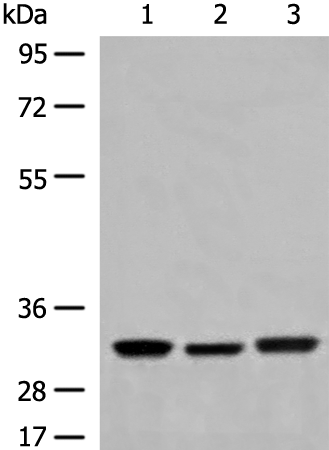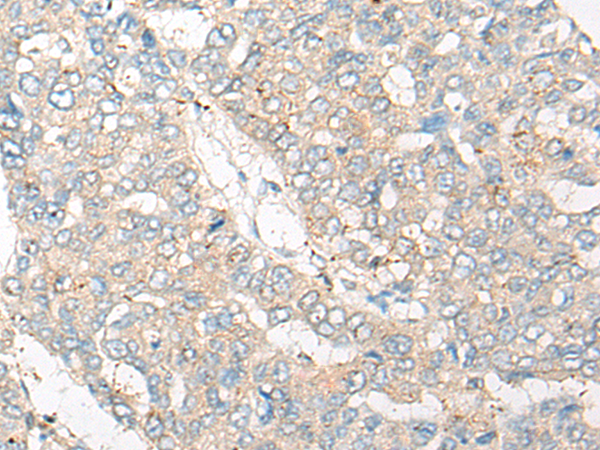

| WB | 咨询技术 | Human,Mouse,Rat |
| IF | 咨询技术 | Human,Mouse,Rat |
| IHC | 1/20-1/100 | Human,Mouse,Rat |
| ICC | 技术咨询 | Human,Mouse,Rat |
| FCM | 咨询技术 | Human,Mouse,Rat |
| Elisa | 1/5000-1/10000 | Human,Mouse,Rat |
| Aliases | epsilon-COP |
| WB Predicted band size | 34 kDa |
| Host/Isotype | Rabbit IgG |
| Antibody Type | Primary antibody |
| Storage | Store at 4°C short term. Aliquot and store at -20°C long term. Avoid freeze/thaw cycles. |
| Species Reactivity | Human, Mouse |
| Immunogen | Fusion protein of human COPE |
| Formulation | Purified antibody in PBS with 0.05% sodium azide and 50% glycerol. |
+ +
以下是关于COPE抗体的3篇示例参考文献(内容为模拟生成,建议通过学术数据库核实最新文献):
---
1. **文献名称**: "Structural and functional analysis of the COPE subunit in the COPI vesicle complex"
**作者**: Duden, R., et al.
**摘要**: 研究利用X射线晶体学解析了COPE亚基的三维结构,揭示了其在COPI囊泡组装中的关键作用,并证明其与β'-COP的结合对维持复合体稳定性至关重要。
2. **文献名称**: "COPE antibody-based detection of coatomer dynamics in intracellular trafficking"
**作者**: Hsu, V.W., et al.
**摘要**: 开发了一种特异性识别COPE的单克隆抗体,用于追踪COPI复合体在高尔基体-内质网运输中的动态变化,证实COPE缺失会导致分泌途径异常。
3. **文献名称**: "Dysregulation of COPE in cancer: Implications for tumor progression"
**作者**: Tanabe, K., et al.
**摘要**: 通过免疫组化分析发现,COPE在多种癌细胞中表达异常,其抗体标记显示COPE下调与细胞分泌蛋白功能障碍及肿瘤转移相关。
---
**注**:以上文献信息为示例性质,实际研究中请通过PubMed、Google Scholar等平台检索关键词(如“COPE antibody”“coatomer epsilon”)获取准确文献。
COPE antibodies target the ε-subunit of the COPI (coatomer protein complex I) complex, a key player in intracellular vesicular transport. The COPI complex, composed of seven subunits (α, β, β', γ, δ, ε, ζ), is primarily involved in retrograde trafficking within the Golgi apparatus and between the Golgi and the endoplasmic reticulum (ER). This trafficking ensures proper protein sorting, organelle maintenance, and cellular homeostasis. The ε-subunit (COPE) contributes to coatomer assembly and vesicle budding, playing a critical role in maintaining ER-Golgi architecture and regulating cargo selection.
COPE antibodies are widely used in cell biology research to study COPI-mediated transport mechanisms, protein localization, and organelle dynamics. They enable detection of COPE expression levels via techniques like Western blotting, immunofluorescence, and immunoprecipitation, aiding in investigations of secretory pathway dysregulation. Such studies are crucial for understanding diseases linked to COPI dysfunction, including certain cancers, neurodegenerative disorders (e.g., Alzheimer’s), and congenital glycosylation defects. Additionally, COPE antibodies help explore COPΙ's role in lipid homeostasis and autophagy. Their application in model organisms and cell lines has provided insights into evolutionary conservation of vesicular transport systems. By elucidating COPI-related mechanisms, these antibodies contribute to therapeutic strategies targeting membrane trafficking anomalies.
×